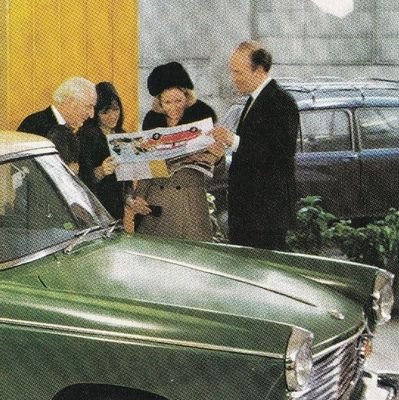Alongside the brochure, Daihatsu produced an accessory catalogue showing all manner of ways the Midget II could be personalised. Fashion-conscious businesses and individuals in Japan bought the tiny vehicle, and used examples have subsequently been exported around the world.
The 660cc Midget II - commonly a single-seater, although a two-seat version was available - was firmly aimed at the Japanese market, but the brochure pictures showed it with a California registration. The model, something of a cult vehicle, was available until 2001.
Renault's first post-war sports car, the Frua-styled Caravelle, is featured in 1100S form in this English-language brochure from around 1964. Related to the rear-engined Dauphine, it was at its purest as a convertible, shown with its detachable hardtop. #carbrochure #Renault
At the time of this 1976 Argentinian Ford Falcon brochure the country was entering a dark period of military dictatorship in which the Falcon acquired a sinister notoriety from its association with death squads who tortured and killed opponents of the regime. #carbrochure #Ford
The two-stroke Auto Union 1000S coupé was a small car marketed as a cut above more ordinary rivals. Launched in 1958, it is charmingly illustrated in this German brochure. The grille features the four rings of the Auto Union, still used by Audi today. #carbrochure #AutoUnion
North American car tastes were very different from the rest of the world in the '70s. The short-lived Ford Elite was a 5.8-litre 2-door 'mid-size' hardtop which was promoted on its 'graceful lines' inspired by the larger Ford Thunderbird 'personal luxury car'. #carbrochure #Ford
Calling the 323 'one of the most conceptually innovative vehicles of its time', the brochure published a styling sketch which looked very unlike the production model. This was the swansong of the 323 (Familia in Japan), which would be replaced in 2003 by the new Mazda3 (Axela).
Special edition time:
Volkswagen Rabbit Black Tie editions (USA 🇺🇸, 1982).
The last of the traditional big Rileys, the 2.6 was made from 1957-59. It retained the looks of the old Pathfinder model, but the venerable Riley engine was binned in favour of a BMC C-series unit. This brochure showed the model as the epitome of gentility. #carbrochure #Riley
In the USA Chrysler badge-engineered the Mitsubishi Galant as the Dodge Colt, but in Canada things were a bit different: it also got a Plymouth twin, the Cricket, seen in this 1974 brochure and available in three bodystyles. #carbrochure #Plymouth




























